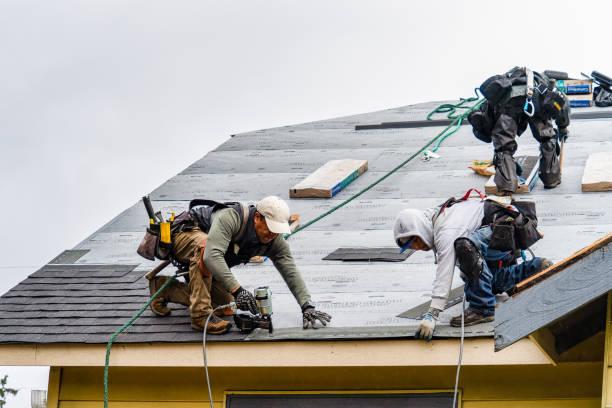Storm Damage Roof Repair: A Step-by-Step Guide

When severe weather strikes, your home’s roof often carries the impact. High winds, heavy rain, hail, and falling debris can cause hidden or visible damage that, if ignored, may lead to costly repairs. Knowing how to identify and address storm-related issues quickly is essential for protecting your property and extending the life of your roofing system. Roof repair after a storm not only safeguards your home from leaks and structural damage but also helps maintain its value and curb appeal. By following a structured approach, homeowners can confidently handle minor repairs or know when to call professionals.
For reliable expertise in restoring storm-damaged roofing, New Horizons Roofing & Gutters LLC provides trusted solutions.
Step-by-Step Guide to Storm Damage Roof Repair
Step 1: Inspect Your Roof Safely
After a storm passes, safety is the top priority. Avoid climbing on the roof until you are sure conditions are stable. Instead, start by inspecting from the ground using binoculars. Look for missing shingles, broken flashing, clogged gutters, or visible sagging. Check for water stains on ceilings and walls inside the home, which often indicate leaks. Early detection is key to effective roof repair and prevents issues from escalating.
Step 2: Document the Damage
Before making any repairs, thoroughly document all visible storm damage. Take clear photos and videos from multiple angles, both inside and outside your home. This documentation is critical if you plan to file an insurance claim. It helps prove the extent of the storm’s impact and ensures you get fair coverage for your roof repair costs.
Step 3: Temporary Protection Measures
If the storm has created openings or leaks, install temporary protection. Use tarps or plastic sheeting to cover exposed areas and prevent water from entering your home. Secure them tightly with roofing nails or heavy-duty tape. Temporary fixes are not substitutes for professional repairs, but they can minimize additional damage until permanent solutions are completed.
Step 4: Assess Shingle and Flashing Damage
Shingles often bear the brunt of storm impacts. Hail can cause granule loss, while strong winds may lift or tear them off entirely. Inspect flashing around chimneys, skylights, and vents since they are common entry points for leaks. Replace damaged shingles and re-secure loose flashing as part of the roof repair process. For larger areas of missing shingles, consult professionals for safe and long-lasting results.
Step 5: Check Gutters and Downspouts
Storm damage isn’t limited to the roof surface. Gutters and downspouts play a vital role in directing water away from your foundation. Clear out debris, check for sagging or detachment, and repair sections that may have loosened. Functional gutters support roof repair efforts by preventing water pooling and structural stress.
Step 6: Repair or Replace Roofing Materials
Depending on the extent of the damage, you may need to patch specific areas or replace sections of roofing material. Asphalt shingles are relatively easy to replace, but tile, slate, or metal roofing may require specialized repair techniques. Roof repair after severe storm damage should be done promptly to restore weatherproofing and maintain the structural integrity of your home.
Step 7: Inspect the Attic and Insulation
Moisture from roof leaks can infiltrate your attic and insulation. Wet insulation loses effectiveness and may promote mold growth. During the repair process, inspect insulation for dampness and replace compromised sections. A dry, well-maintained attic supports energy efficiency and protects your home’s interior.
Step 8: Professional Roof Inspection and Repair
While minor issues can be managed by homeowners, severe or complex damage requires professional expertise. Certified roofing contractors have the tools, training, and safety equipment to handle extensive repairs. A professional assessment also ensures hidden damage, such as compromised underlayment or structural issues, is not overlooked. Investing in professional roof repair enhances durability and peace of mind.
Step 9: Prevent Future Storm Damage
Roof repair is only part of the long-term solution. To reduce future storm risks, schedule regular roof inspections, reinforce weak areas, and trim overhanging branches that could cause impact damage. Consider installing impact-resistant shingles and upgrading gutter systems for enhanced storm resilience. Preventive measures extend the lifespan of your roof and minimize repair costs over time.
Conclusion
Storm damage can compromise the safety, comfort, and value of your home. By following this step-by-step roof repair guide, homeowners can effectively manage the aftermath of severe weather while ensuring long-term protection. From inspection and documentation to professional repair and prevention, every step matters in safeguarding your investment. For comprehensive roof restoration services tailored to storm recovery, New Horizons Roofing & Gutters LLC is a trusted partner in keeping your home secure.
FAQs
1. How soon should I schedule roof repair after a storm?
You should begin the repair process immediately to prevent water infiltration and further structural damage. Temporary measures can be used until full repairs are made.
2. Does homeowners’ insurance cover storm damage roof repair?
Most policies cover storm-related roof damage. However, coverage depends on the cause, extent of damage, and policy terms. Always document damage and consult your provider.
3. Can I perform roof repair myself, or should I hire a professional?
Minor repairs like replacing a few shingles may be manageable. However, for extensive damage, it’s safer and more effective to hire a licensed roofing contractor.
4. How can I tell if my roof has hidden storm damage?
Signs of hidden damage include water stains, musty odors in the attic, or unexplained energy bill increases. A professional inspection can detect problems not visible.
5. What roofing materials are most resistant to storm damage?
Impact-resistant shingles, metal roofing, and slate offer superior durability against hail and wind damage compared to traditional asphalt shingles.
- Art
- Causes
- Best Offers
- Crafts
- Dance
- Drinks
- Film
- Fitness
- Food
- Games
- Festival
- Gardening
- Health
- Home
- Literature
- Music
- Networking
- Other
- Party
- Religion
- Shopping
- Sports
- Theater
- Wellness



